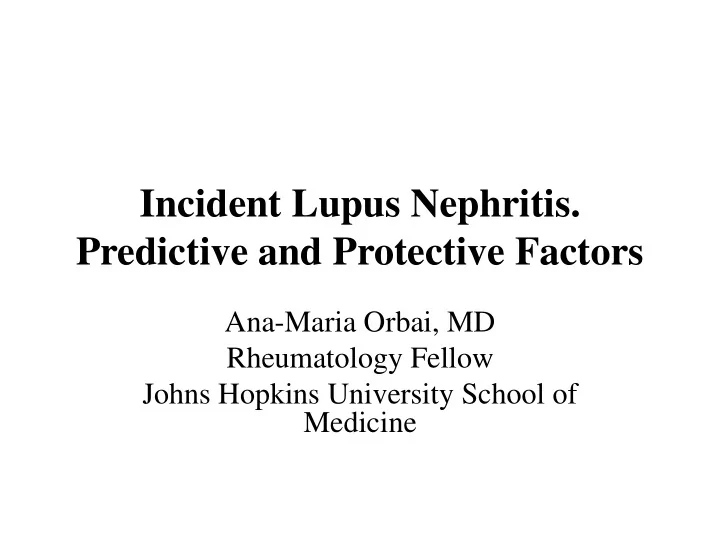

Incident Lupus Nephritis. Predictive and Protective Factors Ana-Maria Orbai, MD Rheumatology Fellow Johns Hopkins University School of Medicine
Background • Lupus nephritis (LN) develops in 50 to 70% of patients with systemic lupus erythematosus (SLE) in their lifetime and is a major cause of morbidity (Petri 1991, Bastian 2002, Pons-Estel 2004) • Early treatment of LN is the single most important predictor of preserving renal function (Austin 1986)
Background –ctd. • Hydroxychloroquine (HCQ) and LN: – delayed LN progression (LUMINA Study Group, Arthritis & Rheumatism 2009) – predicted LN remission at 12 months on immunosuppressive therapy (Kasitanon 2006)
Background – ctd. • ACE inhibitors and LN: – delayed LN onset independent of blood pressure reduction (S. Duran-Barragan, Rheumatology 2008)
Aims 1. To study if HCQ, ACE inhibitor or the combination of the two, are associated with a lower incidence of LN 2. To identify predictor variables for incident LN
Novelty • HCQ has not been studied in the prevention of LN
Hypotheses 1. HCQ protects SLE patients from developing LN 2. HCQ and ACE inhibitors have added benefit in protecting SLE patients from LN
Methods • Patients: – JH lupus cohort: longitudinal study of outcomes in SLE patients from the Baltimore area – quarterly follow-up • Setting: academic center • Design: prospective cohort
Outcome New onset LN: • Proteinuria • 3 or 4+ on dipstick urinalysis or urine protein >500 mg on spot urine or 24h collection • reproducible at 3 months • Biopsy diagnosis
JH Lupus 1986 Cohort Patients, 2047 Renal involvement No renal at cohort entry, involvement, 747 1300 Incident No proteinuria proteinuria Lupus Other No biopsy Nephritis pathology Present
Statistical analysis • Estimation of relative risk of incident LN with the variable of interest (including HCQ, ACE inhibitor, both) • Pooled logistic regression to estimate the association between characteristics and rates, adjusting for confounding by other variables
Statistical analysis – ctd. • Other covariates: – Demographics – Comorbidities (HTN, diabetes, hypercholesterolemia) – Clinical and serologic variables – Steroid use – NSAID use – Immunosuppressant use
Limitations • HCQ blood levels were not measured (to account for inter-individual pharmacokinetic variability or non-adherence) • Single center study • Academic center
Future directions • Prevention of LN would have significant impact on the morbidity of patients with SLE • The effects of HCQ could be studied in a randomized controlled trial of different dose ranges
Acknowledgements • Michelle Petri M.D. M.P.H., Director of the Hopkins Lupus Cohort • Laurence S. Magder Ph.D. M.P.H., Department of Epidemiology and Public Health, University of Maryland
Acknowledgements • Tariq Shafi M.D. M.H.S., Division of Nephrology, Johns Hopkins University • Mark Woodward Ph.D., Department of Epidemiology, Bloomberg School of Public Health Members of my small group Evelyn Gathecha M.D. Justin Lafreniere M.D. Tamorah Lewis M.D. Melanie Nies M.D. Gaurav Raman M.D.
Recommend
More recommend